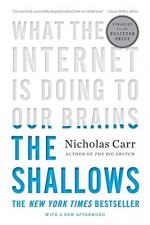
|
| Name: _________________________ | Period: ___________________ |
This test consists of 15 multiple choice questions and 5 short answer questions.
Multiple Choice Questions
1. Which researcher carried out the first studies that showed people's brains changing in response to Internet use?
(a) Michael Mezenich.
(b) Nicole Speer.
(c) Gary Small.
(d) Gayle Peterson.
2. Which book did Christine Rosen of the Ethics and Public Policy Center first try to read on a Kindle?
(a) War and Peace.
(b) The Nix.
(c) Nicholas Nickleby.
(d) A Tale of Two Cities.
3. Which short story did Canadian researchers ask subjects to read in 2001 as a way of testing how people retain information when reading in different formats?
(a) The Stranger.
(b) The Snows of Kilimanjaro.
(c) The Demon Lover.
(d) The Yellow Wallpaper.
4. In Chapter Eight, what concern does Carr cite critics as having voiced about Google's commercial control over the distribution of digitized books?
(a) A restriction in the flow of knowledge.
(b) That rural areas with poor Internet access would suffer.
(c) Too much overload on Google's servers.
(d) That eventually only the wealthy would be able to access digital books.
5. What does Carr say about the state of electronic books in Chapter Six?
(a) They are sure to outpace book sales in the next few years.
(b) They are sure to be a centerpiece of Apple's business model in the next several years.
(c) Despite years of hype, most people have not shown much interest in them.
(d) They are sure to replace books entirely by the end of the decade.
6. In Chapter Seven, what does Carr cite the Roman philosopher Seneca as having said 2,000 years ago?
(a) Sorry is the scribe who splits his time between two scrolls.
(b) To run is but to hide for a short time.
(c) You can be a jack of all trades, but a master of none.
(d) To be everywhere is to be nowhere.
7. What did the first researcher to show how people's brains change in response to Internet activity use to scan the brains of his subjects?
(a) MRI.
(b) X-ray.
(c) Ultrasound.
(d) Sonic imaging.
8. In Chapter Five, what does Carr say we do not think of libraries as, even though they are?
(a) Publicly funded.
(b) The front lines of social welfare.
(c) Media technologies.
(d) Meeting places.
9. What is Google's Silicon Valley headquarters called?
(a) The Church.
(b) The Googleplex.
(c) The Manlo Park Building.
(d) The Lab.
10. In Chapter Six, what does Carr say is the one form of popular media that has been most resistant to the Net's influence?
(a) The record player.
(b) The television.
(c) The book.
(d) The DVD player.
11. What does researcher Gary Smalls say that using the Net is like in terms of how the brain has to work, in some ways?
(a) Doing a crossword puzzle.
(b) Running.
(c) Watching television.
(d) Eating.
12. What is one of the newest branches of the New York Public Library, according to Carr in Chapter Five?
(a) The Queens Library Center.
(b) The Fifth Street Library Center.
(c) The Bronx Library Center.
(d) The Bryant Park Library Center.
13. In Chapter Eight, what does Carr say about the lives of Internet companies?
(a) They often burn themselves out.
(b) They are rarely nasty or brutish, but they do tend to be short.
(c) Their biggest challenge is getting start-up money.
(d) Their biggest challenge is finding talent to run them.
14. In Chapter Six, what does Carr say is one of the more popular of the new digital readers?
(a) Samsung's tablet.
(b) Toshiba's tablet.
(c) Apple's iPad.
(d) Amazon's Kindle.
15. What was an early version of Google called in 1996?
(a) FindOut.
(b) BackRub.
(c) SearchMe!
(d) ModernWorld.
Short Answer Questions
1. In Chapter Seven, what does Carr argue the Net commands with a far greater insistency than television or radio?
2. What topic did Google founder Larry Page select for his dissertation at Stanford?
3. In Chapter Five, what does Carr argue that hyperlinks do in a text?
4. What letter do people's eye movements roughly trace the shape of when they read content online, according to researcher Jakob Nielsen?
5. What does Carr say is Johnson's primary kind of knowledge in the end of Chapter Seven?
|
This section contains 731 words (approx. 3 pages at 300 words per page) |

|




